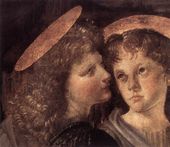Leonardo Da Vinci (continue)
Verrocchio's workshop, 1466–1476
In 1466, at the age of fourteen, Leonardo was apprenticed to one of the most successful artists of his day, Andrea di Cione, known as Verrocchio. Verrocchio's workshop was at the centre of the intellectual currents of Florence, assuring the young Leonardo of an education in the humanities. Other famous painters apprenticed or associated with the workshop include Ghirlandaio, Perugino, Botticelli, and Lorenzo di Credi. Leonardo would have been exposed to a vast range of technical skills and had the opportunity to learn drafting, chemistry, metallurgy, metal working, plaster casting, leather working, mechanics and carpentry as well as the artistic skills of drawing, painting, sculpting and modeling.Much of the painted production of Verrocchio's workshop was done by his employees. According to Vasari, Leonardo collaborated with Verrocchio on his Baptism of Christ, painting the young angel holding Jesus’ robe in a manner that was so far superior to his master's that Verrocchio put down his brush and never painted again. This is probably an exaggeration. On close examination, the painting reveals much that has been painted or touched up over the tempera using the new technique of oil paint, the landscape, the rocks that can be seen through the brown mountain stream and much of the figure of Jesus bearing witness to the hand of Leonardo.
Leonardo himself may have been the model for two works by Verrocchio, including the bronze statue of David in the Bargello and the Archangel Michael in Tobias and the Angel.
By 1472, at the age of twenty, Leonardo qualified as a master in the Guild of St Luke, the guild of artists and doctors of medicine, but even after his father set him up in his own workshop, his attachment to Verrocchio was such that he continued to collaborate with him. Leonardo's earliest known dated work is a drawing in pen and ink of the Arno valley, drawn on 5 August 1473.


Comments
Post a Comment